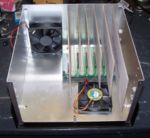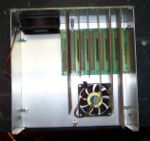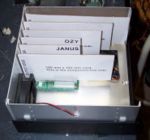Difference between revisions of "PANDORA"
| Line 54: | Line 54: | ||
== CURRENT STATUS == | == CURRENT STATUS == | ||
| + | |||
| + | ==='''Update, 26 May 2007.'''=== | ||
| + | |||
| + | Progress continues on Pandora. From what I've heard from the folks that manned the HPSDR booth at Dayton Hamvention, a common question was "Got an enclosure?" After some discussion on the reflector, it was decided that Pandora needed to move from the "analysis of alternatives" stage to focusing on a design based on the Ten-Tec BK-959 case. For sure, the Ten-Tec BK-959 isn't perfect. But, it's a good quality case, especially considering that the price for one off the shelf at Ten-Tec is about $50. | ||
| + | |||
| + | The next thing on the "to-do" list for Pandora is to create solid models of the components and the case. This is in progress. Below is a picture of Janus model that is still in the works: | ||
| + | |||
| + | [[Image:Janus model.jpg|300x400px|A solid model of the Janus board, not yet complete.]] | ||
| + | |||
| + | A fellow HPSDR enthusiast who for now wishes to remain anonymous has stepped forward to help generate solid models of the existing HPSDR component boards, so this task should be far shorter than if I were doing it alone. | ||
| + | |||
| + | Ben, KD5BYB. | ||
==='''Update, 23 April 2007.'''=== | ==='''Update, 23 April 2007.'''=== | ||
Revision as of 14:32, 26 May 2007
Contents
PANDORA ENCLOSURE CONCEPT
The project leader for the Pandora Enclosure is Ben Hall [1], KD5BYB.
BACKGROUND
The Pandora name is taken from the old story of Pandora’s Box. One particular telling of the story states that Pandora’s Box was a holding vessel for all of the misfortunes of mankind. However, Pandora opened the box and all the misfortunes came out. However, Pandora was able to close the box quickly, and hope stayed inside. It is hoped that since Pandora has let all the evil out of the box with hope remaining inside, our Pandora’s box will have already had all of “smoke” let out, leaving only hope and goodness inside.
The Pandora Enclosure is actually not just a box, but a collection of "building block" like parts that can be utilized in the construction of an enclosure for an HPSDR. Early on, it was determined that each HPSDR user had unique requirements for the enclosure of thier HPSDR. With a "building block" concept, each HPSDR user can chose only the parts they will use from the collection:
An End Panel
This will be an end panel with slots punched out in a fashion similar to what is on the rear of a desktop computer. It will mate to a Commercial Off-The-Shelf (COTS) enclosure. It will also have provisions to allow Close-Out Strips to be attached as well as having provisions to mount the End Panel to a Bottom Plate.
Close-Out Strips
These strips will be of several designs. They will act like the metal brackets on the back of a standard desktop computer card - they'll fit the punched out slot in the End Panel and will have openings that match each HPSDR card. Some strips will be "blank," allowing closing out of unused slots.
A Bottom Plate
The bottom plate will have provisions to accept an Atlas card and provide provisions for mounting the bottom plate to the End Panel, allowing alignment of cards plugged into Atlas with the slots in the End Panel.
DESIGN GUIDELINES
The Pandora design is going to be an attempt to hit a moving target. There are cards currently undergoing design and test as this is being written. Therefore, unfortunately, the Pandora design will somewhat constrain card design. Its hoped that these constraints won’t be too much:
1) Atlas will be the “backplane” card for Pandora.
2) Pandora will accept cards no larger than 100 by 220 mm.
3) Pandora won’t be able to house an amplifier or other card with significant heat dissipation. (Discussions already point to a future power amplifier requiring a power supply in excess of what Atlas can support.)
4) Pandora will try to be as friendly as possible for non-USA HPSDR users. Ideally, this will include selection of a commercial enclosure available outside the USA. If not, the parts will be made as flat as possible for the lowest cost in mailing.
5) Pandora will try and minimize the amount of custom-made parts and focus on what can be obtained off the shelf.
6) Pandora will allow for easy access to the cards contained within with minimal disassembly. It is expected some users will use Pandora to house future HPSDR prototype cards.
7) Pandora will follow the standard HPSDR procedures. It won’t be designed in a vacuum and user input will be sought.
8) Materials chosen will allow for the best possible mix of shielding and easy of modification. Ideally, the outer case will be steel for durability and shielding with the remainder of the parts being aluminum for ease of modification.
9) Of course, it should look nice!
FUTURE CHALLENGES
As Pandora is hitting a moving target, any information on what folks are thinking in the following areas would help:
1) Power consumption / Heat dissipation. So far, with Ozy/Janus, this appears to not be a big deal.
2) Card size. Right now, Ozy/Janus are on the smaller end of the possible sizes for cards. If future cards are going to trend closer to the 220 mm maximum, this would be good to know now.
3) Power supplies. If a pico ITX power supply is used (see www.mini-box.com), very little dedicated space is needed for a power supply. If something larger will be the norm, the enclosure size may have to grow.
CURRENT STATUS
Update, 26 May 2007.
Progress continues on Pandora. From what I've heard from the folks that manned the HPSDR booth at Dayton Hamvention, a common question was "Got an enclosure?" After some discussion on the reflector, it was decided that Pandora needed to move from the "analysis of alternatives" stage to focusing on a design based on the Ten-Tec BK-959 case. For sure, the Ten-Tec BK-959 isn't perfect. But, it's a good quality case, especially considering that the price for one off the shelf at Ten-Tec is about $50.
The next thing on the "to-do" list for Pandora is to create solid models of the components and the case. This is in progress. Below is a picture of Janus model that is still in the works:
A fellow HPSDR enthusiast who for now wishes to remain anonymous has stepped forward to help generate solid models of the existing HPSDR component boards, so this task should be far shorter than if I were doing it alone.
Ben, KD5BYB.
Update, 23 April 2007.
It's been awhile since an entry has been made here, but progress has not stopped! Have had discussions with Ten-Tec regarding BK-959 shielding - as pointed out on the reflector, Ten-Tec confirms that the BK-959 as-is doesn't ground the top and bottom case halves (clamshells) to the inner peices of the case. They presented a simple modification that would allow this to take place. This modification design as well as another are being evaluated now. Have had lengthy discussions with Buckeye Shapeform regarding their line of cases - so far, they are above the $50 US price target by a factor of two. Have also checked out Lansing enclosures, they too exceed the price target by a factor of two.
The case search will continue, but it appears that even with the problem noted above, the BK-959 case is a viable option. For photo/discussion purposes, a physical model was constructed:
Discussion of the Photos Above:
The Atlas card is mounted up about 0.4" (10.5mm or so) from the chassis by small screws. Atlas is located such that the input/output connector edges of the cards are flush with the rear panel. It may be preferable to have the input/output connector edges protrude slightly thru the rear panel (see End Panel disscusion above).
(Note: what is called the front/rear panels here may be reversed in your application, depending if you want the card input/output connectors at the front or rear. This is simply a handy nomenclature for this discussion.)
Two fans are included to give some idea of scale. The fan in the rear of the first three photos is a standard 80mm square computer power-supply fan. The fan laying flat is a slightly smaller, 70mm square fan that is only 15.5mm thick. The fan laying flat shows that there is space under the cards for a fan(s) or card-to-card cabling. The cards installed from left to right are 185mm, Janus, Ozy, 160mm, 185mm, and 220mm.
As can be seen, if the Atlas card is fully populated with 220mm length cards like the one on the far right in the first three photos, there is no room for any sort of controls on the front panel. Yet, if the maximum card length is restricted to 185mm, one has about 1.5" (38.76mm) of front panel control space. For shorter cards, space increases of course.
Ben, KD5BYB.
Update, 2 April 2007.
Have contacted Ten-Tec and confirmed that they do not have non-USA distribution on their fine line of enclosures. Have contacted Buckeye Shapeform and am evaluating their line of cases as another potential source for Pandora; will ask them about non-USA distribution. Received input from several non-USA HPSDR enthusiasts, am exploring cases sold by HiFi in Italy (HiFi2000) and by Vero and by Schroff (links forthcoming). Any other sources of cases from abroad or from here in the USA are welcome at the e-mail link above! Still working End Panel design, have rough preliminary concept laid out that slots the entire End Panel. Status entry below updated to reflect year 2007 instead of 2006.
Ben, KD5BYB.
Update, 25 March 2007.
Initial entry to HPSDRwiki. Ordered and received prototype of Ten-Tec BK-959 case. Received PDF and AutoCAD drawings of BK-959 from Ten-Tec. Have drawn up and fabricated cardboard mock-ups of the possible sizes of HPSDR cards ranging from 100 mm by 120 mm all the way to the maximum size of 100 mm by 220 mm. Currently working on End Panel design, have expanded design from 6 slots (which matched Atlas exactly) to as many slots as the End Panel will allow. This allows users to use the "extra" slots for expansion. Have inquired with Ten-Tec as to non-USA distribution possibilities. Working on contacting Buckeye Shapeform as another source of enclosures.
Ben, KD5BYB.




